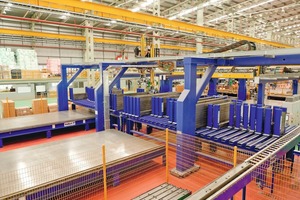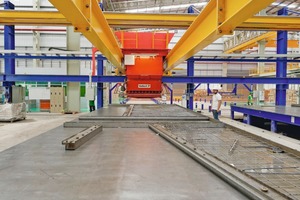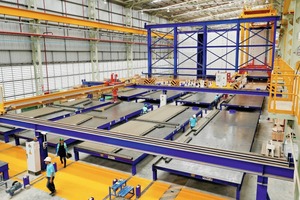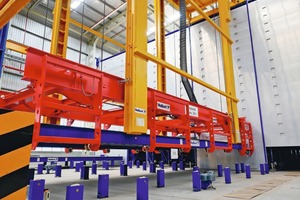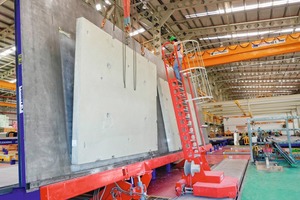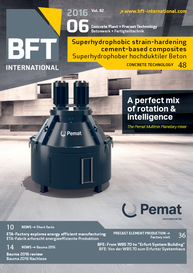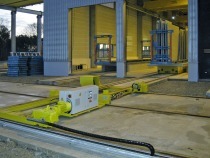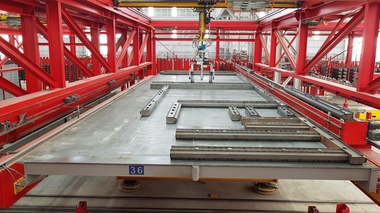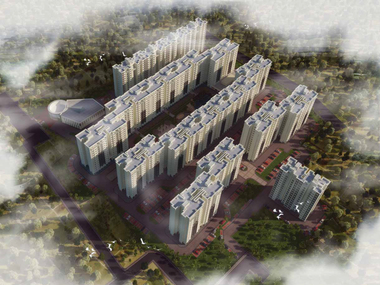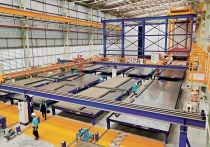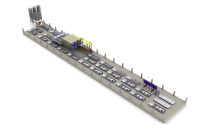Thai SCG Group invests in modern precast concrete production
Since the 1970 s, Thailand has experienced a rapid economic boom. In spite of current political instability, the demand for real estate in the cities remains uninterrupted. The national construction industry continues to invest in the most modern technology for precast concrete production, including the SCG Group.
In the future, up to 2,200,000 m² of solid concrete parts will be produced annually in Sarabury and Chonbury, to the north-east and south-east of Bangkok. For walls and slabs in grade A, premium quality, the SCG group (Siam Cement Group) relies on state-of-the-art plant technology and a sophisticated stockyard solution for efficient loading and logistics processes.
Investment isn’t self-evident. Currently active exclusively as one of the leading cement producers in the ASEAN region, signs pointed to further growth in 2013 and to the development of additional strategic sustainable business areas. For several years, Thailand has increasingly focused on precast construction techniques as a modern, low-cost building system. “For us, this was nevertheless new territory, and the corresponding plant technology was a big challenge,” describes Vitas Suriyachan, On-Site Manager at SCG Cement, with regard to the initial situation at the start of the project. “Building in precast architecture requires a lot of know-how. With Vollert, we have selected an experienced plant designer that not only supplies the latest technology, but also adjusts the technical production processes precisely to customer requirements.”
2,200,000 m² solid concrete parts for rural regions
The market potential for new affordable residential area, especially in the growing rural regions in the districts around Bangkok, is immense. “With new construction projects, real estate developers are increasingly tapping in to the outer city districts and communities,” explains Steffen Schmitt, Executive Sales Director Asia at Vollert. In order to implement the required solid concrete parts capacities of more than 2,200,000 m², the decision was made to erect a new, highly modern precast plant for plane wall and slab elements on green fields in the strategically important cities of Sarabury and Chonbury.
The basis is formed by a unified technology platform of Vollert plants. CAD/BIM software from Precast Software Engineering for building modelling provides the basic data. This results in selection options for capacity distribution of order between the two locations. In addition to the geometry of the concrete parts, the project department data also include information about the required output quantities, time lines, and all logistics flows.
BIM and highly automated plant technology
From serial production of standardized wall and slab elements to complex special parts, all processes ranging from 3D building planning and the production of precast parts to delivery to the construction site are completely matched to each other. Scalable 3D data for precast concrete elements are derived from building models (Building Information Modelling/BIM). In this case, the BIM solution Allplan Precast from Precast Software Engineering offers powerful functions for high-efficiency and high-quality planning of automated precast elements. The Unitechnik master computer accepts the data models directly from the CAD system and controls the production process fully automatically.
“A constantly high-level output quantity of 200 m² per hour of walls and slabs requires a highly efficient plant structure in particular” explains Suriyachan. “We focus on solid concrete parts with a thickness of 98 mm. We implement this using fixed side rails.”
Positioning of the shuttering systems on the pallets relies on high-efficiency robot technology featuring fully automated processes. A magazine robot with twin grippers for a simultaneous moulding and demoulding process initially accepts the cleaned forming profiles that have been coated with release agent from the transport belt and then supplies the subsequent shuttering process directly or stores the profiles temporarily in the existing storage magazine. In this the shuttering profiles are automatically magazined, although the type and alignment of the profiles are detected in advance, while the magazine arrangement is rotated accordingly. A Smart Set shuttering robot with high precision places the shuttering profiles with high speed and movement acceleration performance values on the prepared shuttering pallet. Plotting the contours and positioning of the shuttering systems is controlled via CAD/CAM.
Extremely short cycle times
A specially designed bucket rail system supplies the solid wall production unit with concrete from a central mixing plant. Concrete spreaders moving in parallel supply both concreting lines in extremely short cycle times. Concreting cycle times under 17 min are therefore able to be achieved. A modern, semi-automatic concrete spreader that is able to move both laterally and longitudinally thanks to a bridge chassis assumes the concreting process. This achieves a larger output surface of 1.90 m.
By reducing the water-cement mixing ratio while maintaining the early stiffness of the concrete, the share of cement may be reduced significantly. The low-frequency compaction of the concrete also allows for an optimal, circular vibrating motion with low noise development.
“One highlight is certainly the smoothing lines arranged in parallel, which allow us to guarantee our customers an absolute exposed concrete quality,” states Suriyachan of SCG Cement. An electrically driven smoothing head featuring blade adjustment and adjustable rotating speeds ensure this. A ceiling-guided Vario Store storage and retrieval machine designed for a surface load of up to 550 kg/m² then assumes the fully automatic storage and retrieval of the pallets into the curing chamber. Up to seven concrete parts may be stored and retrieved each hour. The Vario Cure curing chamber consists of four encased rack towers featuring 16 pallet trays each.
Tailor-made stockyard solution implemented
“The high level of automation continues in logistics processes,” explains Steffen Schmitt of Vollert. “For up to 2,200,000 m² of wall and slab area annually, it is important to have equally high-efficiency processes for lifting and loading technology.” The vertical lifting of the solid concrete elements is performed by two high-performance tilting stations. This occurs up to a maximum tilt angle of 80 °. The Vario Tilt tilting station also possesses a hydraulically positionable support beam. The support beam moves against the fixed edge formwork, thereby preventing the concrete element from sliding during the tilting process.
A Smart Logistic lifting truck with a lifting capacity of up to 32 t connects the loading area with the storage area outside. “A specially developed stockyard solution was tailor-made to suit the customer’s needs,” continues Jürgen Hesselbarth, project manager at Vollert. The lifting truck receives the depositing frames and transports them over a distance of 140 m to the 36 loading positions. A fully automatic 2-girder overhead crane then places the frame with the solid concrete parts in the predefined collection location, similar to in a port container terminal.

